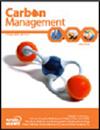Higher carbon sequestration on Swedish dairy farms compared with other farm types as revealed by national soil inventories
IF 3.2
4区 环境科学与生态学
Q3 ENVIRONMENTAL SCIENCES
引用次数: 2
Abstract
Abstract Small changes in the large stock of soil organic carbon (SOC) can have a substantial influence on the climate impact of agriculture. We used information from a Swedish soil monitoring program, in combination with farm census data, to analyze decadal SOC concentrations and SOC stock changes on dairy farms compared with other farm types, and to quantify the climate impact of these changes on dairy farms. Soil monitoring data included topsoil samples from two inventories on 159 dairy farms, 86 beef farms, 318 arable farms, and 13 pig farms, taken at the same locations in 2001–2007 and 2011–2017. Concentrations of SOC on dairy farms (3.0%) were significantly higher than on arable farms (2.3%) and pig farms (2.4%), but not significantly different from beef farms (3.1%). SOC concentration was correlated with proportion of ley at farm scale. SOC stocks in the upper 20 cm increased significantly on dairy, beef, and arable farms, by 0.38, 0.14, and 0.21 Mg C ha−1 year−1, respectively, between 2001–2007 and 2011–2017. For dairy farms, this corresponded to −1.4 Mg CO2 ha−1 and approximately −0.22 kg CO2 kg−1 energy-corrected milk, demonstrating that SOC changes could have a substantial influence on the climate footprint of milk.国家土壤调查显示,瑞典奶牛场的碳固存量比其他类型的农场高
土壤有机碳(SOC)储量的微小变化会对农业的气候影响产生实质性影响。我们利用瑞典土壤监测项目的信息,结合农场普查数据,分析了与其他农场类型相比,奶牛场的碳含量和碳储量的年代际变化,并量化了这些变化对奶牛场的气候影响。土壤监测数据包括2001-2007年和2011-2017年在同一地点采集的159个奶牛场、86个肉牛场、318个耕地场和13个养猪场的表土样本。奶牛场有机碳浓度(3.0%)显著高于耕地场(2.3%)和养猪场(2.4%),与肉牛场(3.1%)差异不显著。农田土壤有机碳浓度与耕地比例相关。在2001-2007年和2011-2017年期间,奶牛场、肉牛场和耕地上20 cm土壤有机碳储量显著增加,分别增加了0.38、0.14和0.21 Mg C / ha - 1年。对于奶牛场来说,这相当于- 1.4 Mg CO2 ha - 1和大约- 0.22 kg CO2 kg - 1能量校正后的牛奶,这表明有机碳变化可能对牛奶的气候足迹产生重大影响。
本文章由计算机程序翻译,如有差异,请以英文原文为准。
求助全文
约1分钟内获得全文
求助全文
来源期刊

Carbon Management
ENVIRONMENTAL SCIENCES-
CiteScore
5.80
自引率
3.20%
发文量
35
期刊介绍:
Carbon Management is a scholarly peer-reviewed forum for insights from the diverse array of disciplines that enhance our understanding of carbon dioxide and other GHG interactions – from biology, ecology, chemistry and engineering to law, policy, economics and sociology.
The core aim of Carbon Management is it to examine the options and mechanisms for mitigating the causes and impacts of climate change, which includes mechanisms for reducing emissions and enhancing the removal of GHGs from the atmosphere, as well as metrics used to measure performance of options and mechanisms resulting from international treaties, domestic policies, local regulations, environmental markets, technologies, industrial efforts and consumer choices.
One key aim of the journal is to catalyse intellectual debate in an inclusive and scientific manner on the practical work of policy implementation related to the long-term effort of managing our global GHG emissions and impacts. Decisions made in the near future will have profound impacts on the global climate and biosphere. Carbon Management delivers research findings in an accessible format to inform decisions in the fields of research, education, management and environmental policy.
 求助内容:
求助内容: 应助结果提醒方式:
应助结果提醒方式:


